REVIVAL OF ADULTS
RESUSCITATION IN ADULTS
What is cardiac arrest?
Cardiac arrest is a condition in which the heart stops working, leading to loss of consciousness, cessation of breathing and circulation. Remember early recognition of cardiac arrest and early onset of compression increases the survival rate. To assess the patient, use the basic approach to the casualty already described.
What is resuscitation, cardiopulmonary resuscitation - CPR?
Resuscitation is a set of procedures and measures that we use in case of cardiac arrest with the aim of restoring circulation.
Resuscitation procedures in adults
CHECK SAFETY
CHECK CONSCIOUSNESS IF IT DOES NOT APPLY
CALL FOR HELP, HMP AND AED
CHECK PULSE, NO PULSE
DO 30 COMPRESSIONS
CHECK, OPEN THE AIRWAY AND GIVE 2 BLOWS
CONTINUE RESUSCITATION 30: 2
WHEN IT ARRIVES THE AED, TURN IT ON AND FOLLOW THE VOICE INSTRUCTIONS
Step One: Security
Assess safety, terrain, personal and patient
Second step: Checking the state of consciousness
You check the state of consciousness, fix the patient's head by placing your palm on the patient's forehead and try to summon him with a light tap on the shoulder. The patient does not respond, is unconscious, immediately ask someone to alert the HMP and bring the AEDs. If you are alone call the HMP and if there is an AED nearby use it.
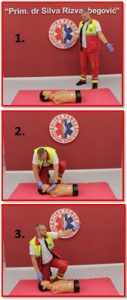
Third step: Checking the circulation
Provjeravate prisustvo pulsa na vratu pacijenta do 10 sekundi, istovremeno posmatrate da li ima pomjeranja grudnog koša. Puls provjeravate tako što slobodnom rukom spustite dva do tri prsta na žlijeb ispod Adamove jabučice na karotidnu arteriju, izvršite pritisak dovoljno jak da osjetite pulsacije. Ako ne osjetite pulsacije puls nije prisutan, pacijent ne diše.

Step 4: CPR - start with chest compressions without delay
Započinjete oživljavanje pacijenta, radite 30 kompresija na grudni koš pacijenta. Radite kompresije tako što kleknete pored grudnog koša pacijenta sa jednim koljenom u nivou pacijentove glave,a drugo koljeno u nivou gornjeg dijela grudnog koša, postavljate se okomito i spuštate korijen dlana jedne ruke na sredinu grudne kosti (preciznije na srednji dio donje dvije trećine grudne kosti) i stavite korijen dlana druge ruke na tu ruku, isprepletite prste obje ruke, ispružite laktove i vršite pritisak na grudnu kost, dubine 5-6 cm, brzina kompresija treba da bude od 100-120 u minuti.
Kompresije i otpuštanje grudnog koša moraju jednako trajati. Ne smijete vršiti pritisak na rebra, samo na grudnu kost. Ne smijete prilikom izvođenje kompresija vršiti pritisak na kraj grudne kosti, zato što možete nanijeti povrede unutrašnjih organa. Prilagodite svoje pritiske na grudni koš konstituciji i dobnoj skupini pacijenta, pogrešno je pravilo da nema uspješne reanimacije bez slomljenih rebara.
Preporuka je ako su prisutna dva spasioca da se mijenjaju svake 2 minute, zbog zamora. Umor značajno umanjuje kvalitet kompresija. Pacijent mora biti na tvrdoj podlozi prilikom izvođenja kompresija.
Cilj kompresija je održavanje dotoka kiseonika ka vitalnim organima. Nakon 3-5 minuta bez kiseonika dolazi do nepovratnih oštećenja mozga.
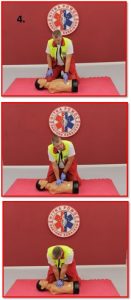
Step 5: Check, airway opening and artificial ventilation
After 30 compressions on the chest, check the airway, clean it if there is any contents, then open the airway by tilting the head and lifting the lower jaw, giving two mouth-to-mouth ventilations to the patient or mouth to mask, if available.
Blow slowly for 1 second and watch for the chest to rise. Perform artificial mouth-to-mouth ventilation by fixing the head with the palm of the patient's forehead, pressing the soft part of the nose with the thumb and forefinger of the same hand, opening the mouth with the other hand, pulling the lower jaw, keeping the airway open and covering the patient's mouth with your lips. inhale the air slowly, making sure that air enters the patient's airway. After one blow, move your mouth away from the patient and allow the air to come out, and then repeat the artificial ventilation procedure.
The air you inhale should pass freely through the airway, if there is resistance, it could be a sign of airway obstruction. If the patient's cheeks are blown while blowing and it is a sign that air is not passing. The reason may be either an airway obstruction or an airway you have not opened. You solve the problem by repeating the maneuver already described to open the airway. If air still does not pass, apply methods to address airway obstruction. If the airway is compromised, all your efforts to implement resuscitation measures will be in vain.
Continue resuscitation at a rate of 30 compressions: 2 ventilations, until the arrival of the AED of the apparatus or 2 minutes (5 cycles of CPR).

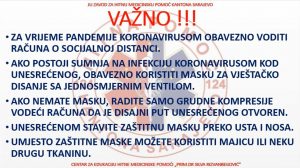
Step Six: Turn on the AEDs
The second rescuer brings the AEDs, turns on the device, and follows the voice instructions of the device. You place the self-adhesive electrodes on the patient's chest, according to the pictorial instructions on the electrodes themselves.
Step 7: Rhythm analysis and energy delivery
The device analyzes the rhythm and delivers an electric shock only if it has recognized the rhythm as shocking.
DURING THE ANALYSIS, YOU MUST NOT TOUCH THE PATIENT !!!
YOU MUST NOT TOUCH THE PATIENT DURING SHOCK DELIVERY !!! Follow the voice instructions of the device.
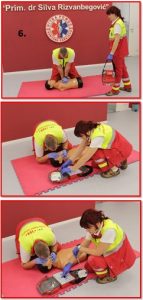
Step 8: Continue CPR
After the power is delivered, the camera gives a voice instruction to continue with CPR for 2 minutes. Do 30 compressions on the patient's chest and 2 mouth-to-mouth ventilations or a mouth mask if available.
Step 9: Re-analyze the rhythm
After two minutes of CPR, the device gives a voice instruction, "step back", follow the voice instructions of the device, you must not touch the patient at the time of analysis and delivery of shock. The device analyzes the rhythm and delivers energy if it recognizes the rhythm as shocking.
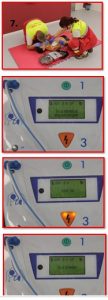
Step 10: Continue CPR, follow the voice instructions of the camera
You continue CPR according to the voice instructions of the camera for 2 minutes. This is followed by a re-rhythm analysis, do not touch the patient while the device is analyzing the rhythm. If the device does not recognize the rhythm as shocking after the analysis, check the presence of a pulse on the patient's neck. If the pulse is absent, you continue CPR.
If a pulse is present, you check to see if the patient is breathing, using the watch, listen and feel method. If the patient is not breathing, you give him 10 ventilations per minute, one ventilation every six seconds.
Ako pacijent diše, stavljate ga u bočni položaj i pratite do dolaska HMP.
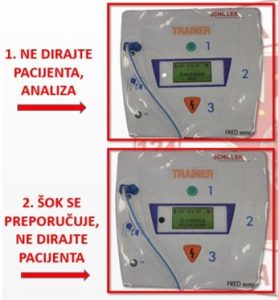
Maybe without a table if it's too much !!!!!
Procedure after analyzing the AED rhythm of the apparatus
Da li je aparat prepoznao ritam kao šokabilan
Da – ritam je šokabilan Ne – ritam nije šokabilan
Aparat isporučuju energiju Provjeravate prisustvo pulsa na vratu pacijenta
Nastavljate CPR, po glasovnim uputama aparata Ne osjećate pulsacije na vratu pacijenta – nema pulsa Prisutan puls na vratu pacijenta
CPR 2 min Nastavljate oživljvanje – CPR Provjeravate da li pacijent diše
Pratite glasovne upute aparata, sačekajte analizu, ne dirajte pacijenta tokom analize CPR 2 minute Ako ne diše Ako diše
Pratite glasovne upute aparata, sačekajte analizu, ne dirajte pacijenta tokom analize Dajete 10 ventilacija u minuti Bočni položaj i pratite pacijenta
When do you stop resuscitation measures?
Resuscitation measures are being implemented:
- until the HMP arrives
- until the patient begins to show signs of life
- to the exhaustion of the rescuer.
